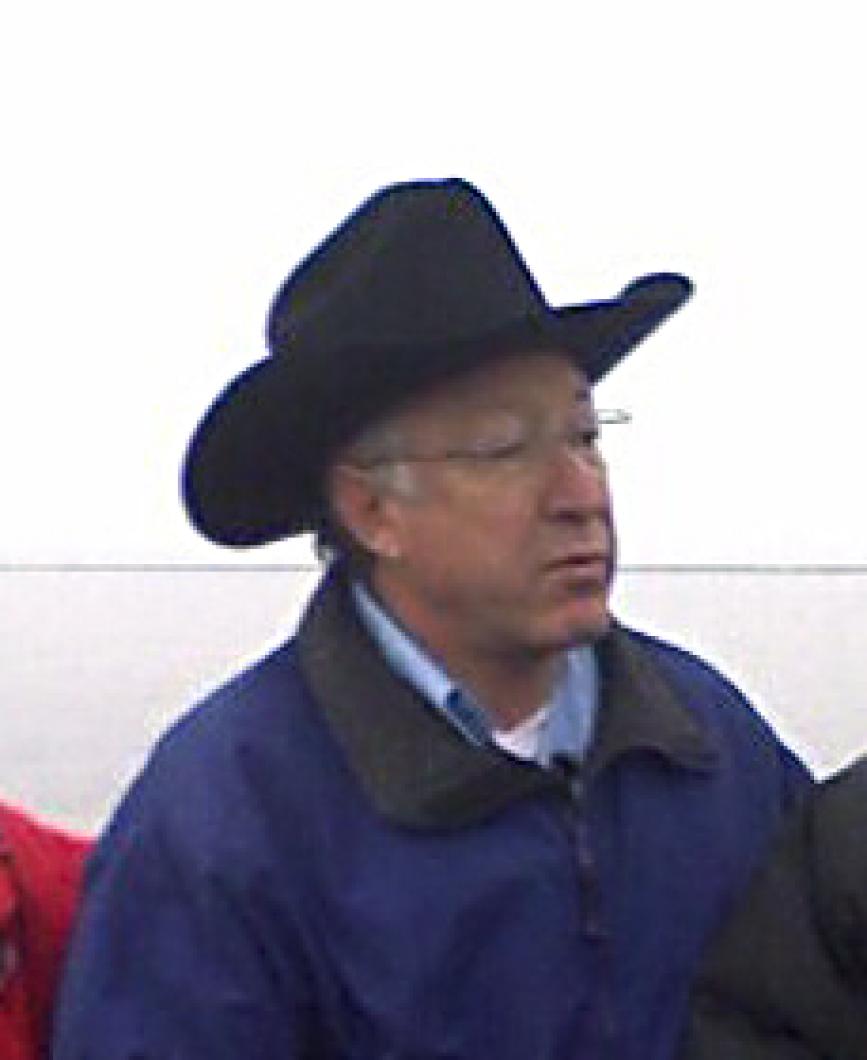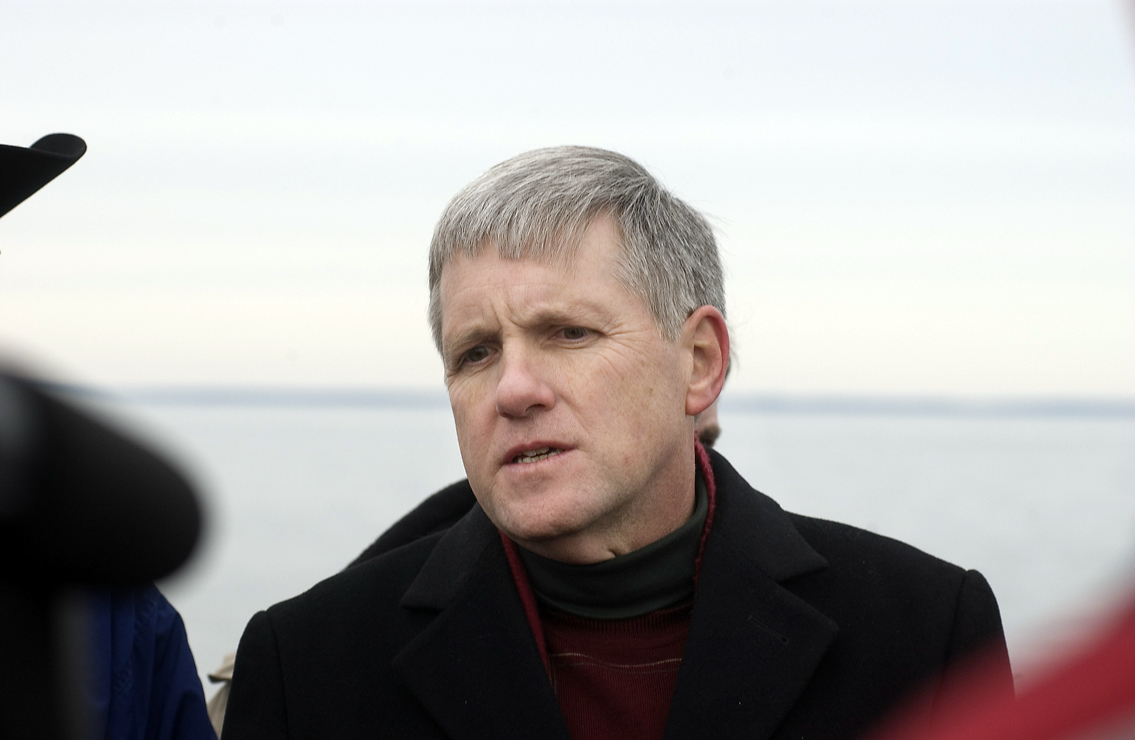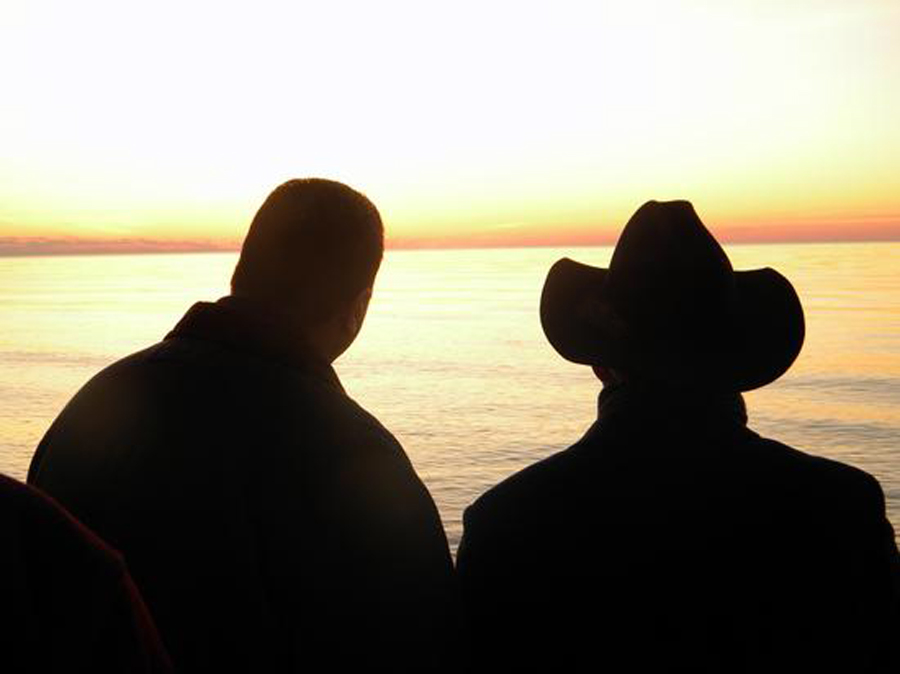Federal Interior Secretary Kenneth Salazar came to the Vineyard and Cape Cod on Tuesday to consult with Indian tribes opposed to the Cape Wind development, then held a press conference on the wind farm site in Nantucket Sound to say that the meetings had not decisively moved his view of the project.
Secretary Salazar said he was “very bullish” about the future of offshore wind energy in general, but that all options were still open regarding Cape Wind’s plan to build 130 turbines on Horseshoe Shoal.
“The conclusion might be that we will simply deny the application, or on the other hand that we will approve the application with conditions,” he told a gaggle of reporters gathered on the foredeck of the Coast Guard vessel Ida Lewis as it stood off a meteorological tower built by Cape Wind in Nantucket Sound.
“I’m not prejudging where we will end up.”
The one thing of which he appeared increasingly sure was that the decision would be his to make. The prospects of any accommodation agreement between the proponents of the development and its critics was highly unlikely.
On the subject of compromise, he said: “I’m not holding my breath.”
And Mr. Salazar reaffirmed his commitment to decide one way or the other by spring.
“We will have a conclusion to this process by April,” he said “I think the worst thing we can do for the country is to be in a state of indecision, and this application has been in a state of indecision for a very long time.”
It now has been more than eight years since Cape Wind Associates first proposed the wind farm. The most recent impediment to the project stems from opposition by two Indian tribes, the Wampanoag tribes of Mashpee and Aquinnah.
State Historic Preservation Officer Brona Simon supported a claim by the tribes that the proposed wind farm would interfere with their spiritual ritual of greeting the rising sun, and would also have significant archeological and historic impacts, because some 5,000 years ago, before it was inundated by rising sea levels, their forebears lived on the area proposed for the development.

Then the National Parks Service backed Ms. Simon’s determination that Nantucket Sound was eligible for listing on the National Register of Historic Places.
Approval of a cultural claim by American Indians over such a large area of water — some 500 square miles — is unprecedented.
Those decisions led to Secretary Salazar’s personal intervention in the process, first with a series of meetings with various interested parties in Washington last month, and again this week.
He began the day before dawn, watching the sunrise with representatives of the Mashpee tribe, and then came to the Vineyard for a tour hosted by tribal leaders, which took him through areas from which the Cape Wind industrial park would be visible, from State Beach to Chappaquiddick.
During that 90-minute tour, the secretary and other senior officials again heard from Aquinnah Wampanoag tribal chairman Cheryl Andrews-Maltais and historic preservation officer Bettina Washington about the impact of the development on tribal culture.
Then in late morning, accompanied by local and national media, Secretary Salazar boarded the Coast Guard buoy tender for the final leg of what he called his fact-finding mission.
Wearing his trademark black cowboy hat and boots, Mr. Salazar used the occasion to enumerate the competing pressures of his role.
On the one hand, he said, the President and the Department of the Interior had made renewable energy “one of the imperatives of our country.” On the other hand, he was required to protect the history of the country and respect the rights of the tribes.
And he said he felt it was important to come here to show respect to the tribes, and to “get the feel and the smell of the place. I had to come out here to their places of significance and actually experience some of what they experience,” he said, adding:
“The general sense of the conversations this morning was to give us a presentation on the importance they put on this particular area, their history, their attachment to this land and the special meaning that it has for them.
“We hear them loud and clear.”
Secretary Salazar also stressed that whatever decision he ultimately makes would be a response to unique circumstances.
“What happens to Cape Wind, whether it goes up or whether it goes down, will not be determinative of the future of wind energy in the United States,” he said, noting that significant funding had been provided in the 2011 budget for additional work on alternative energy.
State governments on the Atlantic seaboard, he said, are talking of generating 20, 30, and 40 per cent of energy from renewable energy resources.
“As a country we have an imperative to harness the power of the wind, and we will do that,” the secretary said.
“I’m very bullish on the future of wind energy in the United States of America, but . . . it’s important to do energy in the right places. That is the critical question we’re addressing here on Nantucket Sound. Is this the right place for wind energy or is it not.”
On Wednesday, the day after Mr. Salazar’s visit, new information was released which further complicates the guessing game of whether Cape Wind will be approved or not: an investigative report by the office of the inspector general of the Department of the Interior into Cape Wind.
The report examined various allegations made by opponents of the project, including the late Sen. Edward Kennedy, about irregularities and improprieties in the assessment process.
The investigation found no serious problems, but it noted that several federal agencies felt “unnecessarily rushed” in completing their submissions for the final Environmental Impact Statement. The haste had not affected the conclusions, the report found.
Yesterday Secretary Salazar issued a statement saying that “although the Inspector General’s report found that the final Cape Wind EIS was not the subject of improper political influence or otherwise deficient,” he had directed Deputy Secretary David J. Hayes to work with Interior Solicitor Hilary Tompkins to provide a recommendation to him.
Meanwhile, Island representatives this week were rushing to meet the short deadline for submissions on a federal government plan to open up some 4,000 square nautical miles of ocean near the Vineyard for potential wind power generation.
The plan was presented to a joint local state and federal renewable energy task force only last week, and Island representatives were given only until today to make their submissions.
Interviews with Island members of the task force this week revealed a range of viewpoints about the latest government salvo in wind development planning, unlike the reaction to the state ocean plan which was uniformly hostile.
The difference appears to be that while the federal proposal covers a vastly larger area, it is also much farther away from the Island — nine miles at its closest point.
Some remain implacably opposed to any development which is not completely invisible from the Island. Chilmark selectman J.B. Riggs Parker, who told last week’s task force meeting any development should be at least 24 miles offshore, said his submission would repeat that demand.
And he condemned the entire task force process.
“I think they have given short shrift to the opinions of the task force,” he said. “It’s like ‘This is what we’re doing, you can make your comments but we’re moving on.’ The process is hideously flawed and phoney.
“I am critical of them for slavishly following the state’s suggestion as to where to put this offshore factory. I think they have no adequate explanation for why they didn’t consider other parts of the Massachusetts coast.”
West Tisbury selectman Richard Knabel, whose critique of the submission appears on the Gazette’s Commentary Page today, is also concerned.
“By designating nearly 4,000 square nautical miles for wind factory leasing off the south shores of the Vineyard and Nantucket, the area’s borders based strictly on water depth and political boundaries, without any prior analysis of limits imposed by shipping routes, whale and bird migration routes, cultural considerations, or fishing grounds, the problems posed by Cape Wind on 25 square miles will be projected onto 4,000 square miles,” he writes.
The tribe also remains opposed to any development anywhere within view of the Vineyard.
But other task force participants see the latest federal proposal as far less objectionable.
County manager Russell Smith said there was not time for the county to put in a submission because it would have required a meeting of all the commissioners to approve it.
“But I think the general consensus was that area was much better than the state’s proposed area,” he said. “It’s nine miles out. And it appears it is outside the bird flyway, instead of being in the middle of it, like the state’s area.” He continued:
“And then there is the viewshed. The thing that really bothered me about the state’s area was that it was so close to the Gay Head Cliffs. Like I said at the meeting, the Cliffs are probably the most prominent geologic feature on the East Coast. But on the south side of the Vineyard, and you’re standing at sea level instead of at an elevated position, looking at a horizon that goes out to Brazil, people don’t rush and get their cameras to take a picture of the line of the horizon. That’s a huge difference.”
Martha’s Vineyard Commission executive director Mark London also found things to like about the federal plan.
“I would make the general comment that the development in federal waters is less problematic than the closer sites,” Mr. London said. “It appears to pose less threat to avian ecology, to boating, and less visual impact.”
That said, though, he said the planning process for opening up the area poses a dilemma.
“I can understand the desire to get the process started by seeking requests for interest from developers, so they don’t add another couple of years to the process of developing wind energy,” he said.
But the Minerals Management Service has done no study at all on potential impediments to development, ecological, archeological and otherwise.
“I think the MMS has a responsibility to get more information out to potential bidders,” Mr. London said, concluding:
“The dilemma is, do you plan it first, or find out first what the developers might want to do with it and then plan accordingly?”












Comments (6)
Comments
Comment policy »